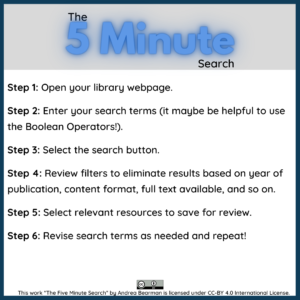How to Successfully Search in Five Minutes
By the end of this chapter, you should be able to:
- Execute better strategies for a successful search using the library website. (LO2)
- Locate scholarly resources in the library website. (LO3)
Need a quick start? Try this five minute search activity. Using what you have learned regarding Boolean Operators and some of the other strategies listed, you should be able to successfully find a relevant resource in five minutes or less. Set a timer and see if you can do it.

Resources and Strategies for a Successful Search
Below are some strategies to try when searching the internet and library databases for information. To learn more, you may want to visit Excelsior College website.
Here are some well-presented ideas to consider when researching. These elements can help you select better research as you work on paper, projects, and for the future.
References for Remixed Content:
Chalabi, M. (2017. April 17). 3 ways to spot a bad statistic [Video]. YouTube. https://www.youtube.com/watch?v=Zwwanld4T1w
Nolan, M. (2012, December 11). How to separate fact and fiction online [Video]. YouTube. https://www.youtube.com/watch?v=sNV4yIyXXX0
Rowson, T. (2020, May 28). Are search results actually biased [Video]. YouTube. https://www.youtube.com/watch?v=FDC122bCbvc
Sheehy, S. (2018, November 26). The case for curiosity-drive research [Video]. YouTube. https://www.youtube.com/watch?v=PlytMrKfOFA

